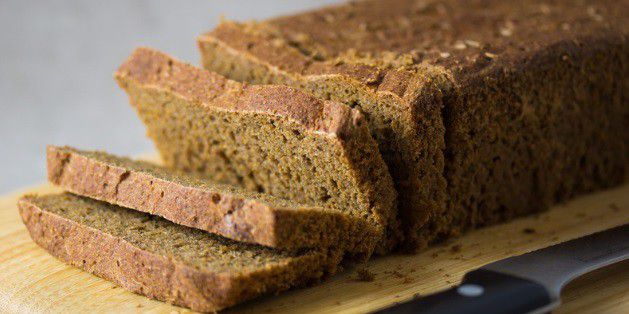
| 10 | 285 | 189 |
| Ingredients | Minutes | Calories |
| Prep | Cook | Servings |
| 4 h | 45 min | 10 |

| 1 3/4 cup | Water, filtered (warm) |
| 3 tbsp | Water, filtered (warm) |
| 2 1/4 tsp | Yeast, active dry |
| 4 cup | Rye flour, dark |
| 1 3/4 tsp | Salt |
| 1 tsp | Cream of tartar (optional; to increase acidity) |
| 3 tbsp | Molasses (for color; optional) |
| 1 tbsp | Granulated sugar |
| 2 tsp | Caraway seed |
| 1/2 tsp | Espresso powder (for color; optional) |
In a small mixing bowl, whisk together the warm water and yeast. Allow the mixture to sit for about 10 minutes so the yeast activates.
In a medium mixing bowl whisk together the dark rye flour, salt and cream of tartar until well incorporated.
In another medium mixing bowl, whisk together the molasses, sugar, caraway seeds, espresso powder and stir until just combined. Whisk in the warm water and yeast mixture from Step 1.
Add the dry ingredients to the bowl containing the wet ingredients and mix with a wooden spoon in one circular direction for 1 minute. Now stir in the opposite direction for 1 minute.
Add about 1 tbsp olive oil to another medium mixing bowl and spread it around the inside with your fingers. Use a spatula to scrape the dough into the oily bowl. With dampened fingers, form the dough into a ball and rotate it around in the inside of the bowl so it's coated in oil.
Cover the bowl with a plastic bag and let it rise in a warm place until it's doubled in size, about 1 ½ hours. Alternatively, place in the refrigerator for about 12 to 24 hours. Remember that we want our dough to double in size regardless of whether it spends a full 24 hours in the refrigerator or rises at room temperature. Feel free to let it rise in the refrigerator for some of the time and outside of the refrigerator the rest of the time.
De-gass the dough by pressing on it with dampened hands several times until no more gas comes out of the dough. Form the dough into a ball again and let it rise until it's doubled in size, about 1 ½ hours. If you did your last rise in the refrigerator, do this rise at room temperature and allow 4 hours of rise time.
The dough can now be proofed by gently forming it into a lightly oiled loaf pan and allowed to sit covered with a plastic bag until it reaches about 80% to 90% of it's intended size, which should be about 40 minutes. The proofing stage is where the dough takes most of it's shape. It's important to leave room under the plastic bag so the dough can rise sufficiently.
Preheat your oven to 375°F (191°C). Remove the plastic bag so the dough can rest for about 10 minutes while your oven is preheating. During the baking process, the dough will rise another 10% to 20% of it's intended size in the process known as 'oven spring'. Bake until the internal temperature of the bread measured with an instant-read thermometer registers 200-210°F (93-99°C). Rotate the loaf 180° in the oven halfway through the baking duration for even baking. If you don't have a thermometer, this is about 40 to 45 minutes or until the bottom of the loaf sounds hollow when the loaf pan is tapped with a blunt object like a rolling pin.
Since this rye bread isn't bound together with gluten we need to wait until it cools completely before removing it from the loaf pan so the vegetable gums can solidify. For best results when slicing this bread, use a designated serrated bread knife and clean the gummy dough off the blade after every three slices. This bread is best stored covered in a cool dark place or pre-sliced and stored in a plastic freezer bag in the freezer.
| Grain | 2.6 |